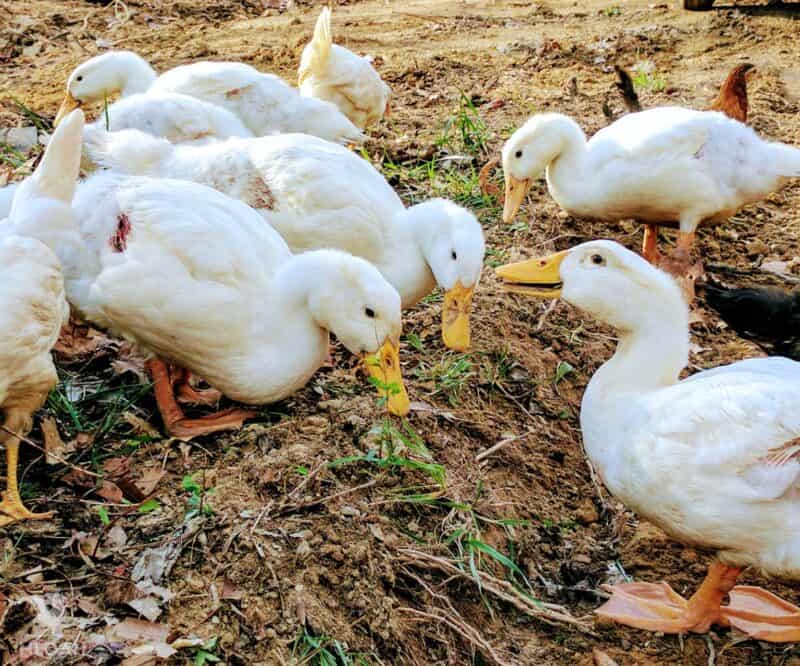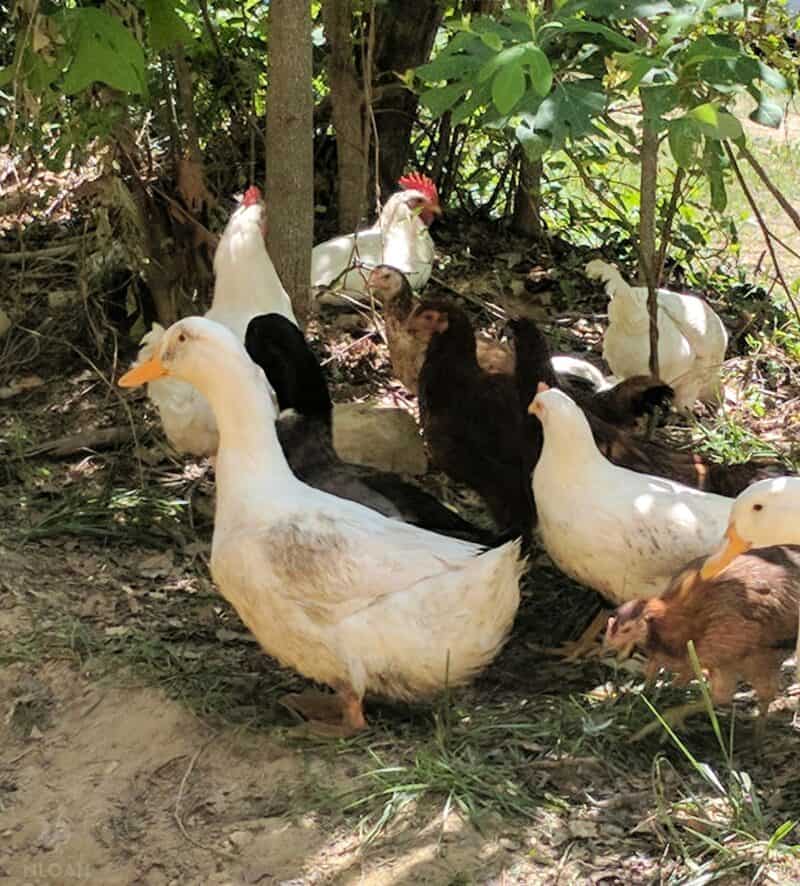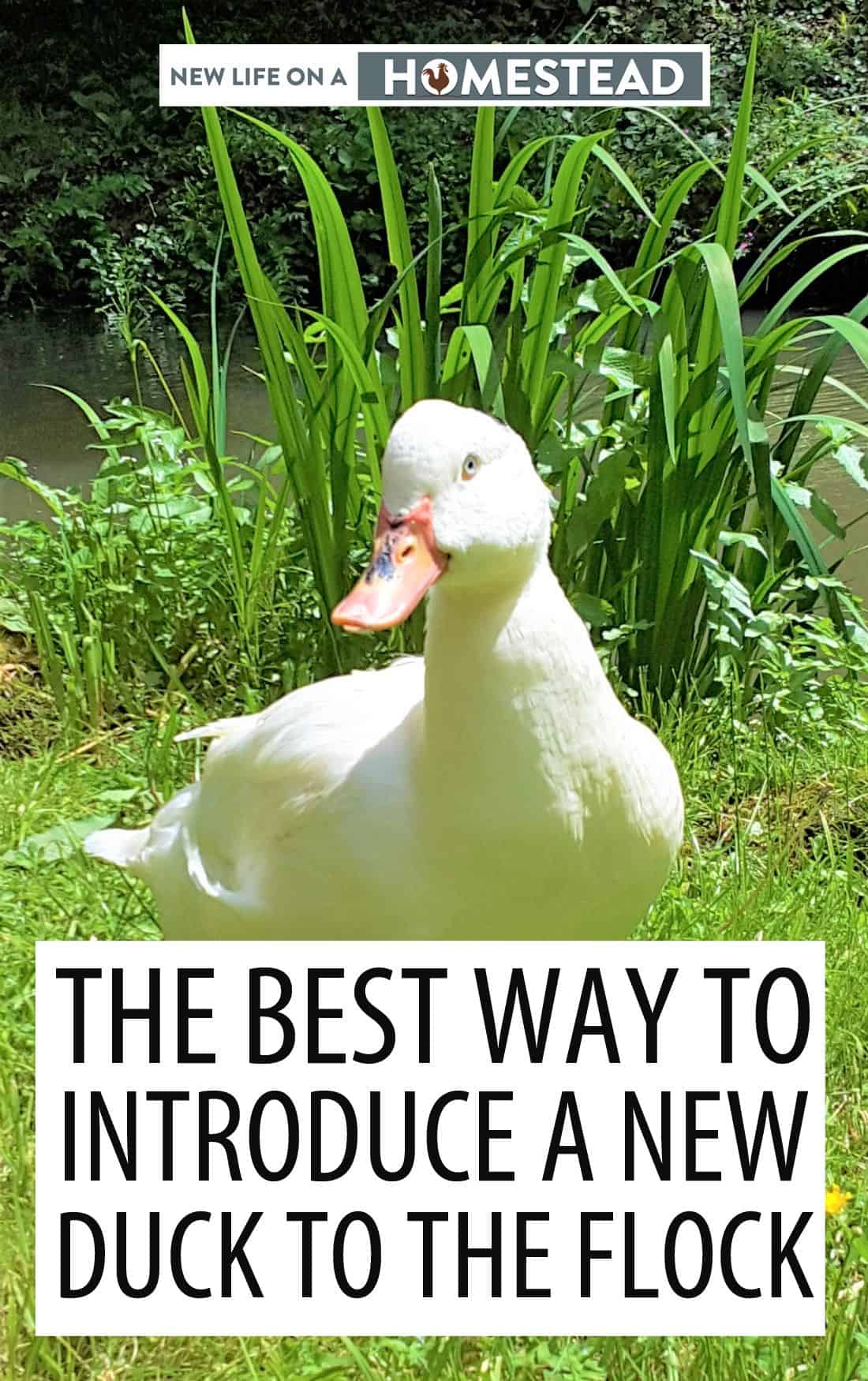You may have started out with just a few ducks, but at some point you will probably decide to add more. So if you keep ducks and you need to add new ones, you may wonder whether they will be accepted and not be bullied by existing members of the flock.
The main thing you need to remember is that this is a job that cannot be rushed. It will take some time to complete the introductions satisfactorily.

The first thing to remember is that when compared to that of chickens, the ducks’ pecking order is not nearly as aggressive or fierce. Chickens are considerably more vicious than ducks.
Expanding your flock can also be easier to establish if you add more than just two or three new birds. A larger group is much less likely to get picked on and bullied.
Follow my advice below for adding new ducks to the flock, and you shouldn’t have any problems at all.
Remember the Hierarchy!
If you have raised chickens, you’ll be very aware that they have an unbreakable pecking order, and it covers all aspects of their daily lives.
Which bird has the right to roost on the preferred perch, which one has priority access to the best food sources are just two examples of the pecking order system in action.
Often it is not possible to analyze the factors that determine the hierarchical system. But of course the deciding factors are not invisible to the hens themselves!
Some chickens are content to accept their position in the structure, but others will be testing the system and trying to assert themselves.
With ducks however, the pecking order is more lenient. This is a good thing when you’re adding new birds to the flock.
You don’t have to worry about the new duck being pecked possibly even to death by an offended incumbent. But you still need to pay attention to the pecking order amongst your flock of ducks, and keep an eye out for any problems in the dynamics of the group.
Season
During the mating season, ducks are considerably more assertive. Male ducks or drakes are alsomore territorial.
Now, most people get new ducklings sometime during the spring, which is when ducks tend to mate. This is when the stores are going to be offering those cute little fluffy ducklings for sale!
It is natural therefore that this is probably when you’re going to be introducing new birds.
This is especially true if you intend to add a new, adult drake to a flock.
Male to Female Ratios
Before you decide to add another adult male duck to your existing flock, consider how many males to females you already have.
Before you add another drake, to your flock, be certain that you have good ratios in the flock. You should have at least three or four females for each drake. This will reduce the odds of the drakes fighting with each-other.
Drakes can bully younger ducks. They can attack young drakes and continually try to mount young females.
Of course, this is another reason to try to avoid the mating season when expanding your flock of ducks. By fall, hormones will have settled, and there is more likely to be peace in the duck house!
You also need to be aware that females can also get hostile. It’s not just the drakes that are aggressive. Females ca be, as well, if there is a drake around, as she wants all new female ducks to know that the drake belongs to her, and to her only.
If you can introduce ducklings or adult female ducks to a flock consisting only of females this is going to be much easier than adding new ducks to an adult flock of mostly females with only one male.
You should wait until your ducks are seven weeks old before you begin the integration process. By then, your new ducks/ducklings will be at least partially feathered. They should be large enough and sufficiently developed to be able to defend themselves.
First Introductions
Plan the first encounter with the new ducks on neutral ground – somewhere far away from the coop. In this way, neither the new nor existing members of the flock have an unfair advantage over the other. Maybe you have some courtyard space where the ducks can free range, meet and start to mix together.
This neutral meeting ground is very important as it will help to minimize territorial situations arising and reduce subsequent problems. The ducks will feel less threatened by the incoming birds. There should also be plenty of space for any bullied duck(s) to flee if necessary.
Although you should be close at hand and on alert should you have to break up a serious duck fight, try not to jump in too quickly. Let nature take its course to as far as possible before you intervene, and try to let your ducks do their thing without your involvement.
Ducks are naturally curious, so as you release the new ducks, you’ll find the existing ones will want to get close and greet the newcomers. They will realize that the new ducks are the same as them, albeit smaller and different in appearance.
Head bobbing is a very common way in which ducks communicate; they may use this gesture to greet the new ducks. This is not a threatening action at all, but a very positive sign that all will be well in the duck house!
Unfortunately, there may be times that you observe a negative reaction. You will recognize such behavior straight away. Bullying tactics and harassment towards the new ducks can, and do happen.
Older ducks may advance towards the smaller, new ones. They may elongate their necks and try to push them over.
If this is all that occurs, and provided the young ducks don’t seem too stressed out, you can simply observe from a distance.
But always need to be on alert for aggressive behavior, for example older ducks biting the smaller ones. If this happens, you should end the initial meeting and keep the ducks separate for now.
Repeat the introductory procedure for a short time each day for about three or four days without a break. Keep the length of the meetings to about 15 minutes each day.
Living Together
After a few days of initiation, the ducks should have accepted each other. Once the old ones no longer pose a threat to the incomers, you have to get them used to their new home.
If at first you are not totally comfortable that the two groups are well integrated, you can separate your run into two parts. In this way, the new ducks will be able to keep to themselves at first in the run, but will still be secure.
After a few days, they will be able to be introduced to the duck house together. You will see that they are starting to get used to each other.
Now, you should separate the sleeping area into two separate parts. The separation is only temporary, so provided it is safe from predators and provides protection from the elements that is all that is required.
Sometimes ducks don’t want to go inside at night. This is especially true if they are nervous of being bullied by other ducks. This is why it is so important to take your time with the introductory phase of integrating the new ducks.
It is essential that your ducks go inside at night, so make sure they are. Even if they would prefer to remain outside, you cannot risk allowing that to happen.
After a few nights, with the ducks getting considerably braver, they can start to roam together, particularly when you are there to supervise.
Mixing and Roaming
Once your ducks have stayed together a few nights in a row, you should let them mingle. Let them all out to free-range together, ideally when you are home to make sure everything is OK.
Notice Any Feathers?
Ok, I hope everything I’ve said so far didn’t scare you. Things will go right most of the time, I’m just trying to cover all bases, and offer a worst-case-scenario that will help to side-step problems in the long run.
You just need to keep an eye out for any serious aggressive behavior, like biting or feather pulling. Keep a close eye on all your ducks, new and old, and make sure they aren’t losing feathers.
If the feather loss can’t be attributed to nesting or molting, it’s almost always due to bullying behavior.

Can I Mix Ducks with Other Poultry?
It’s not a good idea to put your ducks into your chicken house. Ducks drink copiously, so their droppings are always very wet. This can lead to sanitary issues with your chickens.
In the winter, the excess liquid contained in duck droppings is liable to freeze. This can lead to additional health problems for your chickens who can suffer from frostbite.
Ducks don’t nest or roost in the same manner as chickens, so their housing requirements are different.
It’s very unwise to keep ducks with geese. Adult male geese are extremely territorial during the breeding season.
Adult female geese are extremely defensive and protective of their nest, eggs and young. Geese can and do kill birds that are smaller than them, including ducks during the mating season. If however you only have young geese the dangers are less.
Are They Eating?
Ducks are by nature greedy birds. So, it is unusual that new ducks won’t eat. But sometimes, new ducks will be refused access to feeding areas by the existing ones.
It’s a good idea to check that there are sufficient feeding points so that any timid birds will not have to compete with other birds for food.
Be extremely vigilant for the first few weeks to make sure each duck is getting adequate amounts of food and if necessary, add more feeders to make sure no one is left starving.
Practice Good Husbandry
Whenever you add a new animal to your existing flock, good husbandry is essential if your animals or birds are to stay healthy.
Sometimes, it’s necessary (and recommended) to quarantine any new birds coming onto your land for several weeks before letting them mingle with the rest. This practice helps prevent any disease or parasite from wreaking havoc into your flock.
Of course you should make sure you know that the ducks you are introducing to your flock are healthy. If possible visit the farm where they have come from. Find out what their previous living conditions were like.
For example, not all ducks will have had access to water. This can lead to them being unable to preen and keep clean by bathing.
Sometimes, the feathers on ducks which haven’t had access to water are unable to repel water when they take a bath. Their plumage becomes waterlogged almost immediately they get into the water. This is a condition known as “wet feather”.
Although normal in small ducklings, this is neither good nor common in adult ducks. Possible causes are mites or lice, cramped living conditions or poor feed. You should check the ducks’ skin carefully for parasites.
If there are no parasites present, and the ducks are eating, then it is a good sign.
There is conflicting advice available about whether you should keep ducks with “wet feather” out of water. Some advise keeping ducks with wet feathers out of water, others advocate encouraging the ducks to bathe.
Providing your water bath is not too deep to pose a drowning danger to the ducks, I personally believe that ducks should have access to water. This gives them the opportunity to clean up their feathers and act as they would naturally.
In almost all cases, with the right care and extra protein, the problem will resolve itself after a molt.
It is likely that once they have molted and started to have regular water baths, the re-growth will be fine. Just make sure to keep up with quality feed and nutrition.
Be Patient
So as we have seen, it can take a little time for new ducks to be added or introduced to your existing flock. Fortunately, ducks aren’t as difficult as chickens in this respect. And they are less discriminatory if you choose to mix ducks of different breeds.
Chickens might attack other birds that don’t look like them (this is where you have to be careful about adding birds from other breeds, in particular), but ducks can still be a bit snooty when it comes to accepting newcomers.
Just remember that acceptance doesn’t always happen overnight. You might think that your new ducks are fully integrated into the flock, only to find that they’re excluded from the rest of the group the next day.
In some cases, it can take up to a full year (or more!) for your flock to be fully integrated. But be assured, this is very rare.
Whenever you add any new livestock, the goal is always to be as patient as possible – this is the most effective method to reduce stress both for you and your new birds.
Finally, try to make sure your birds are 7-8 weeks old when you acquire them.
Sometimes, birds are too small for their age, in which case it’s a good idea to wait before starting any integration plan.
You’ll need to follow different steps to add new chickens to a flock. But the tips above can be used for adding new geese to a flock, too.


Sally is a retired English lawyer who spent 20 years homesteading on the Welsh hillsides in the U.K.
Semi-retired, she moved to France 15 years ago, where she and her husband set about restoring a 14th century watermill which came with 5 hectares of woodland, riverbank, and pastureland.
Using the skills and experience gained in the U.K, they continue to enjoy working on their land, woods and water.

Thank you for this! We already know the basics, but I really appreciate the fact that you stated that sometimes it may take longer. We have 3 very spoiled runners and have recently had to introduce 2 fully grown pekins. The pekins came from a less than advantageous situation, and are settling in well. Our uptight runners, however, are not very keen to share their housing. We will separate it, as suggested, and continue to be patient! Thanks again.